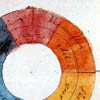

Colours are the deeds of light; its deeds and sufferings: thus considered we may expect from them some explanation respecting light itself.
DESCRIPTION
The cpthsv utility reads a colour palette, converts its colours to HSV (if needed), modifies these values in some simple ways, converts back to the original colour-space (if needed) and writes the result. So cpthsv can (de)saturate, brighten, darken or hue-shift.
Currently, RGB and HSV colour-spaces are transformed, other spaces and fill-types will pass
through without being modified. (The --verbose option reports the
number of segments transformed.)
The program will read from stdin if a file is not specified as
the final argument, and write to stdout if the --output option is not specified.
The hue value is taken to be between 0 and 360, while the saturation and value components are taken to be between 0 and 1,
OPTIONS
--backtrace-filepath-
Specify a file to which to write a formatted backtrace. The file will only be created if there is a backtrace created, typically when an error occurs.
--backtrace-formatformat-
Specify the
formatof the backtrace written to the files specified by--backtrace-file, one ofplain,xmlorjson. -h,--help-
Brief help.
--hingevalue-
Specify the z-
valueof the hinge in the cpt file. If there is no hinge directive (i.e., aSOFT_HINGEorHARD_HINGE) in the input, then this option has no effect.When normalising (with the
--z-normaliseoption), this gives the z-value in the input which is mapped to zero. That z-value must be one of the stops in the input.When denormalising (with the
--z-denormaliseoption), this gives the value in the output to which zero in the input is mapped. This option can be viewed as the counterpart to the+happended to thevalue-Coption for the makecpt (1) . --hinge-active-
If the input cpt has a
SOFT_HINGEdirective, then activate that hinge (resulting in independent scaling of the two halves of the gradient either side of the hinge).If the input does not have such a directive, then this option has no effect.
-o,--outputpath-
Write the output to
path, rather thanstdout. -T,--transformstring-
Specify a transformation to perform. One of
h,sorvfollowed by anumberand optionaloperation. The effect of the number depends on the operation: one ofx(multiply bynumber),%(scale by percentage) or+/-(add or subtract value). An RGB colour with saturation 0.5 would be transformed to one with saturation 0.55 by applyings1.1xors110%ors0.05+. If the operator is not given then%is assumed.Transforms which take colours outside the HSV colour-space are permitted, the result is truncation (eg, increasing a saturation of 0.8 with
s0.3+results in a saturation of 1.0). The exception is hue, which will error if transformed outside the 0–360 range.Multiple transforms can be applied by separating transforms with commas. This is to be preferred over multiple calls to the program since the conversion between colour-spaces is necessarily lossy. Multiple transformations are applied in the order given in the argument.
-v,--verbose-
Verbose operation.
-V,--version-
Version information.
-z,--z-normalise-
Normalise the z-values in the cpt output into the range 0/1 (or to -1/1 if a hinge is present) and add a
RANGEdirective if not present in the input. This is the form used in GMT master files.This option requires that output cpt version is at least 5.
-Z,--z-denormalise-
Set the z-values in the cpt output into the range given by the
RANGEdirective, and remove that directive. If there is noRANGEthen this option does nothing. -4,--gmt4-
Use GMT 4 conventions when writing the cpt output: the colour-model code is uppercase, and the colours are separated by spaces.
This is incompatible with the
-5and-6options of course.At present this option is the default, but that will change at some point. So specify this option if your use of the output depends on the GMT 4 layout (consumed by a custom parser, for example).
-5,--gmt5-
Use GMT 5 conventions when writing the cpt output: the colour-model code is lowercase, and the colours are separated by a solidus for RGB, CMYK, by a dash for HSV.
This is incompatible with the
-4and-6options of course. -6,--gmt6-
As the
-5option, but allows theHARD_HINGEandSOFT_HINGEdirectives in place of the explicitHINGE =directive.This is incompatible with the
-4and-5options of course.